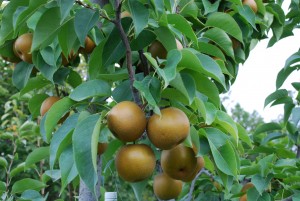Whether home-grown or store bought, Asian pear (Pyrus pyrifolia) fruits ripen sweet and tasty on the tree (USDA hardiness zones 4-9). There are over 100 varieties available worldwide, many with difficult to pronounce.
Investigate variety cold hardiness and winter chilling rating as some cultivars are hardier than others. Southern varieties require only 300- 600 hours of winter chilling temperatures (under 45°F) to set a crop annually. They ripen on the tree (ready to eat) compared to European pear varieties that are first harvested and ripened off the tree.
Asian pears trees bear fruits in 2-3 years compared to European pears in 4-5 years. Plant bare root trees either in late winter or in early fall. You will need to plant two or more different varieties to insure good cross pollination. Trees should be set 12-15 feet apart in a well-drained, moderately acidic soil; keep the graft union 2-4 inches above ground.
Trees should be pruned during late winter. Asian pears exhibit different growth habits than European pears. Asian pears are smaller trees (usually 8 feet to 12 feet tall). Some branches develop very narrow crotch angles, which may break under a heavy crop load.
Trees should be trained to a modified leader system. At planting, cut back the central leader to 36-42 inches above the ground to encourage lateral shoots. These shoots become the main scaffold branches. Remove any broken, low branches and root suckers at any time.
Do not fertilize newly planted trees in year one. Going forward, fertilize trees annually with granular 10-10-10 or equivalent. Keep trees mulched around the base. Loosely wrap chicken wire or mesh around trunk of newly planted fruit trees to protect the tender bark from rabbits and field mice (voles). The wire should be removed after two years.
Asian and European pears have their share of disease and pest problems. Consult fruit spray guides published by your state land grant university. Some Asian pears varieties are more disease resistant than others. Unfortunately, both Asian and European pears are susceptible to fireblight.
Depending on variety and growing region, Asian pears are ready for picking from mid-July to early-October. Fruits are thin skinned.


 Posted in
Posted in 
